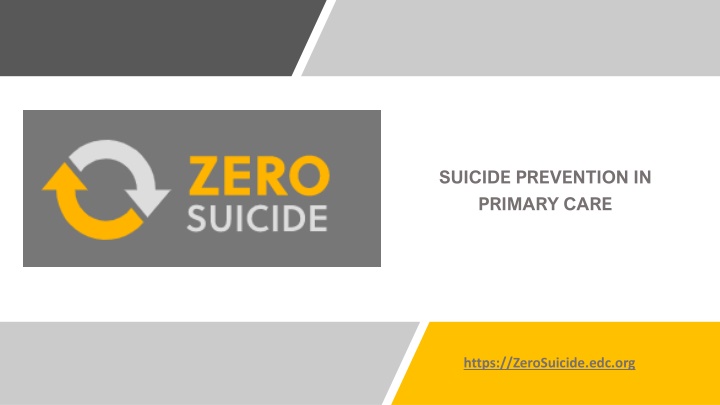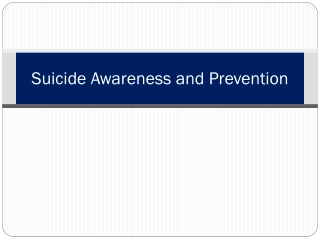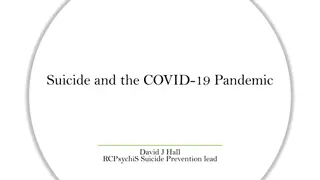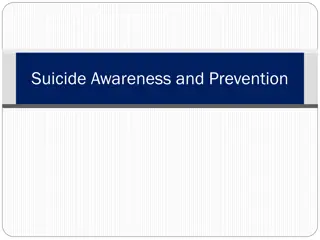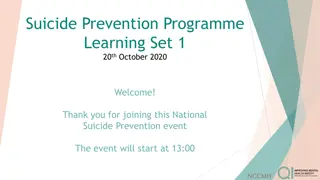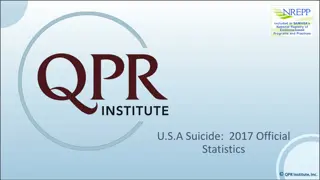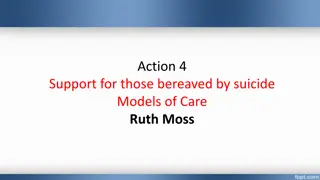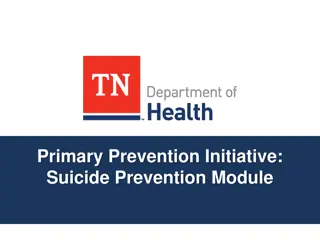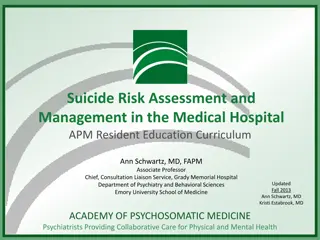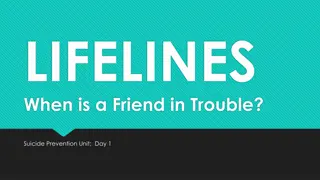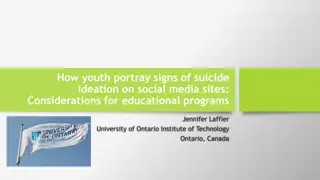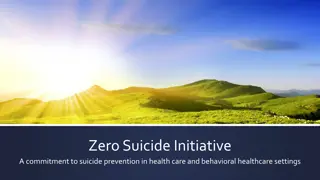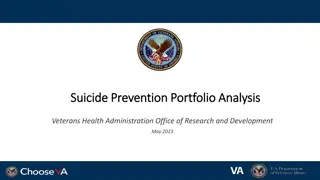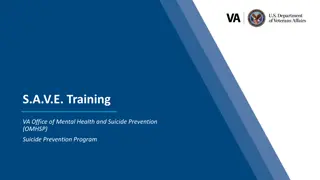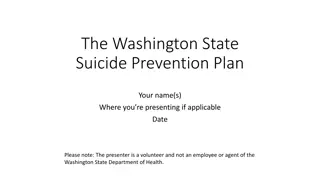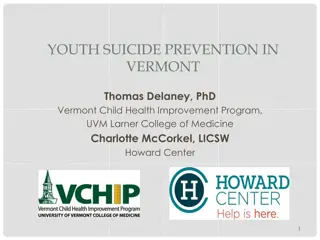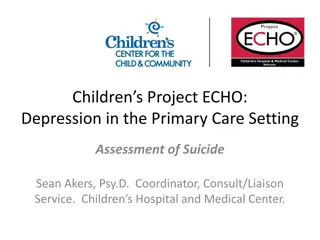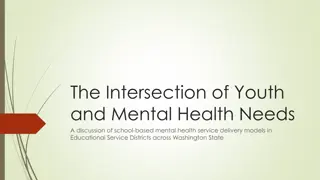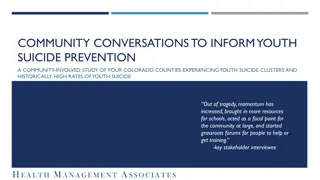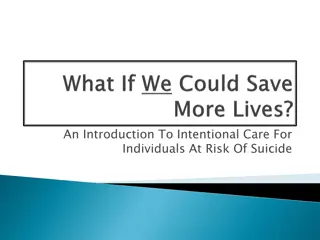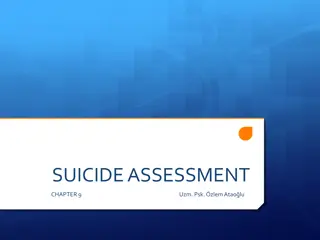Suicide Prevention in Primary Care
Suicide prevention in primary care is a crucial aspect of saving lives. Suicide, the 10th leading cause of death in the U.S., often involves individuals who have recently interacted with healthcare providers. Patients expect physicians to address factors impacting their health. Strategies like reducing access to lethal means, such as firearms, can be effective in preventing suicides. The Zero Suicide initiative focuses on system-wide transformation, evidence-based clinical care, and culture change to eliminate suicide in populations under care.
Download Presentation

Please find below an Image/Link to download the presentation.
The content on the website is provided AS IS for your information and personal use only. It may not be sold, licensed, or shared on other websites without obtaining consent from the author.If you encounter any issues during the download, it is possible that the publisher has removed the file from their server.
You are allowed to download the files provided on this website for personal or commercial use, subject to the condition that they are used lawfully. All files are the property of their respective owners.
The content on the website is provided AS IS for your information and personal use only. It may not be sold, licensed, or shared on other websites without obtaining consent from the author.
E N D
Presentation Transcript
SUICIDE PREVENTION IN PRIMARY CARE https://ZeroSuicide.edc.org
Suicide can be prevented in Primary Care Suicide is the 10th leading cause of death in the U.S. Of those dying by suicide, approximately 45% will have seen their primary care provider within the month before their death, while only 20% will have seen a mental health professional in that period. Over 38% of individuals have made a healthcare visit (eg., primary care, emergency department, specialty care, etc) within the week before their suicide attempt and 95% have had a health care visit within the preceding year. Adult patients report that they expect their physician to ask about lifestyle factors that could impact their health and are open to advice. Reducing Access to Lethal Means Limiting access to medications and chemicals and removing or locking up firearms and other weapons are important actions to keep patients safe. Many suicide attempts occur with little planning during a short-term crisis. 90% of attempters who survive do NOT go on to die by suicide later. Access to firearms is a risk factor for suicide. Reducing access to lethal means saves lives.
Zero Suicide Mission & Principles Zero Suicide Mission & Principles Mission QI model designed for system-wide transformation Transform the way health systems care for people with suicidal urges Culture change to a Zero-based mindset Foundational Principles Core Values the belief and commitment that suicide can be eliminated in a population under care by improving service access and quality and through practicing continuous quality improvement. Systems Management taking systematic steps across systems of care to create a culture that no longer finds suicide acceptable, setting aggressive but achievable goals to eliminate suicide attempts and deaths, and organizing service delivery and support accordingly. Evidence-Based Clinical Care Practices adopting practices that research shows reduce suicide deaths and behaviors and that are delivered through the entire system of care and that emphasize productive patient-staff interactions.
Zero Suicide Elements Lead system-wide culture change committed to reducing suicides Train a competent, confident, and caring workforce Identify patients with suicide risk via comprehensive screenings Engage all individuals at-risk of suicide using a suicide care management plan Treat suicidal thoughts and behaviors using evidence-based treatments Transition individuals through care with warm hand-offs and supportive contacts Improve policies and procedures through a continuous quality improvement plan
Core Element: Lead System-wide commitment Establish implementation team Schedule regular meetings Leaders at all levels serve as champions Authority for developing and changing guidelines Continuous QI to ensure fidelity Assist with training and maintaining culture of Zero Suicide Assess elements of safer suicide care currently in place Adopt a comprehensive suicide care approach and develop policy Establish positions responsible for ensuring fidelity to the model
Core Element: Train Staff require skills and confidence to provide excellent care All employees receive training appropriate to their role Ensure that training contains the following elements: The fundamentals of the organization s Zero Suicide philosophy Policies and protocols relevant to the staff member s role and responsibilities Basic, research-informed training on suicide identification for all staff Additional training to all clinical staff to ensure a basic level of skill in assessing, managing, and treatment planning for patients at risk of suicide, including safety planning and reduction of access to lethal means Advanced training to deepen skills and increase confidence and effectiveness Train new staff and provide refresher training at least every 3 years
Core Element: Identify Screening for Suicide Risk Policies and procedures clearly describe screening patients for suicide risk, including: The frequency of screening Documenting risk screenings Screening and identification workflows How staff will be alerted when their patients screen positive for suicide risk Completion of full risk formulation for patients screening positive for suicide risk Further assessment to establish severity of suicide risk https://cssrs.columbia.edu/ A written policy and procedure specifies that patients are provided timely access to clinically trained staff after screening positive for suicide risk. A standardized screening measure is used by all staff. Staff receives formal training on suicide screening and documentation.
Core Element: Engage All individuals identified to be at risk of suicide are engaged in a pathway to care during the appointment. Safety Planning Brief and in the patient s own words Involve patient s family/supports as full partners in the collaborative process Include a plan for lethal means safety Be in the patient s possession when they leave the appointment Be updated whenever warranted Intervention is documented in the patient EHR. Counseling on Access to Means (CALM) is an online training offered free of charge by the Suicide Prevention Resource Center. Recommended that all clinical and in some cases non-clinical staff members complete.
Core Element: Treat Clients with suicide risk are treated in the least restrictive setting possible. Evidence-based interventions include interventions and treatment that are designed to target suicide risk directly. Safety Planning is a list of coping strategies and sources of support developed by a clinician in collaboration with the patient Reducing access to lethal means Teaching brief problem-solving and coping skills Enhancing social support and identifying emergency contacts Using motivational enhancement to increase likelihood of engagement in further treatment Brown_StanleySafetyPlanTemplate.pdf (suicidepreventionlifeline.org)
Core Element: Transition Care transitions are high-risk times for patients. Bridge transitions: primary care behavioral health care primary care The burden lies on the provider to develop systems to ensure that patients make and keep appointments. Address suicide risk at every visit and handoff in the primary care setting. Policies provide guidance for successful care transitions and specify the contacts and supports needed throughout the process. Track/manage the patient s pathway to care through follow-up and supportive contacts.
Policies for Safe Care Transitions Develop internal written policies and procedures for safe care transitions: When the patient is referred to a provider or service both within or outside of your organization When the patient transitions to another organization or provider in the community When the patient terminates services, either independently or in agreement with the care provider When the patient repeatedly misses appointments Following a patient s contact with crisis services At discharge from an ED or a psychiatric hospital Train staff on policies and procedures for safe care transitions. Ensure that patients receive education about the model of care and the rationale for treatment as they move from one clinician to another, or from one agency/setting to another. Monitor to ensure that care transitions are documented and flagged for action in an electronic health record or a paper record.
Creating Smooth Care Transitions Establish safety plan with patient and provide copy before referral Ensure the patient has spoken by phone with the new provider Call/send relevant patient information in advance of the appointment Contact the patient within 24 48 hours after they have transitioned to the next care provider and document the contact Caring contacts are follow-ups that show support, promote connection, and increase collaboration. In-person, phone calls, text messages, postcards, and e-mail messages
Core Element: Improve Determine how closely the elements of the model are being followed. Check on quality. Help identify opportunities for improvement. Provide feedback regularly to senior leadership and staff on progress toward patient-care goals in conjunction with the systems, policy, and patient care practice changes being made in the organization s Zero Suicide approach.
Chickasaw Nation DHS Implementation Suicide Care Workflow All patients receive PHQ with further C-SSRS assessment for positive screens. If positive screen, assess for level of suicide risk: Low risk- Create a collaborative safety plan as part of identified process Moderate risk- Use clinical judgment of life context and screening scores to assess whether patient can be safe utilizing safety plan and support system or would be best treated in an inpatient facility. High Risk- Plan with the family for patient to be admitted to inpatient, complete safety plan. Coordinate transport unless clinician s judgment determines patient can leave with family member. Safety Planning using Stanley Brown tool. Allows the patient to identify positive coping strategies, members of their support system, and important contact information for those whom the patient can call on if needed. Follow-up: Before the patient leaves the facility, create a follow-up appointment/phone call. Utilize administrative staff to identify no-shows and track those at the highest risk so they can be contacted. Encourage patients to complete our Heartline contact consent form. Heartline is an outside hotline that assists with patient follow-up. It is of great importance to make these follow up appointments for the patient before they leave so they experience little to no gap in services, including medication refills. Prior to our Zero Suicide implementation, patients who received inpatient care did not receive standardized follow-up contact post-discharge, and at times our care processes would end when the patient left our facility. Now, for patients who are referred to inpatient care we have created a unique discharge form that includes their follow up information and upcoming appointments. Chickasaw Nation Departments of Health and Family Services | Zero Suicide (edc.org)
https://zerosuicide.edc.org/sites/default/files/Transforming%20Systems.pdfhttps://zerosuicide.edc.org/sites/default/files/Transforming%20Systems.pdf
Resources Zero Suicide Zero Suicide Institute Zero Suicide 2-page overview document Zero Suicide Toolkit Zero Suicide --Suicide Safer Care Guide for Primary Care Providers Suicide Prevention Toolkit for Primary Care Practices | Suicide Prevention Resource Center Zero Suicide Data Elements Worksheet Zero Suicide Organizational Self-Study Counseling on Access to Lethal Means Health Care | National Action Alliance for Suicide Prevention The Columbia (C-SSRS) Brown_StanleySafetyPlanTemplate.pdf (suicidepreventionlifeline.org)
